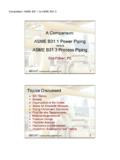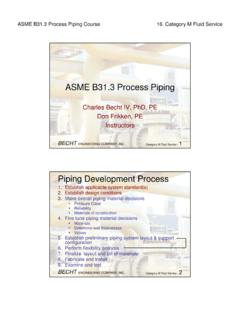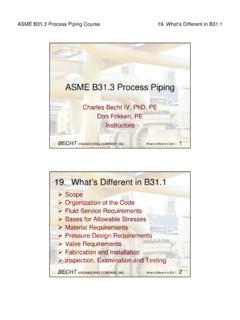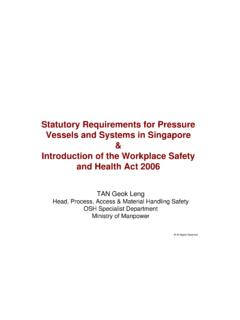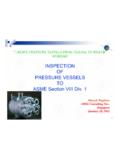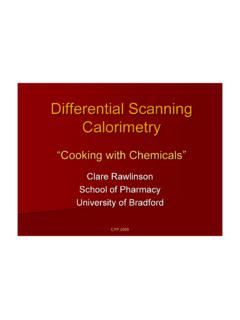Transcription of ASME B31.3 Process Piping - psig.sg
1 asme Process Piping Course18. In-Service PipingBECHTENGINEERING COMPANY, Piping -1 asme Process PipingCharles Becht IV, PhD, PE Don Frikken, PEInstructorsBECHTENGINEERING COMPANY, Piping -218. In-Service Piping API 570 Piping Inspection Code Responsibilities What to Inspect Types of Inspection Inspection Practices Frequency and Extent of Inspection Remaining Life Calculation Repairs and Alterations ReratingASME Process Piping Course18. In-Service PipingBECHTENGINEERING COMPANY, Piping -3 API 570 Piping Inspection Code For inspection, repair, alteration, and rerating of in-service metallic Piping systems Applicable to Piping systems constructed in accordance with asme First Edition, June 1993 Second Edition, October 1998 Addendum 1, February 2000 Addendum 2, December 2001 BECHTENGINEERING COMPANY, Piping -4 API 570 Piping Inspection CodeAPI 570 includes flammable and toxic services.
2 It excludes specific requirements for: Water, steam, steam-condensate, boiler feed water and Category D fluid service Piping systems that are an integral part or component of rotating or reciprocating mechanical devices Piping or tubing with an OD NPS 1/2 Nonmetallic Piping and polymeric or glass-lined Piping Plumbing fired heater and boiler internals are also excluded The excluded Piping can be included at the owner-user s option. asme Process Piping Course18. In-Service PipingBECHTENGINEERING COMPANY, Piping -5 ResponsibilitiesOwner-user:Has overall responsibility for compliance with API 570 and developing, documenting, implementing, and executing the inspection, repair, alteration, and reratingPiping Engineer:Responsible to the owner-user for design, engineering review, analysis, and evaluation of Piping systemsRepair Organization:Responsible to owner-user for providing materials, equipment, quality control, and workmanship to maintain and repair the Piping system in accordance with API 570 Inspector:Responsible to owner-user for determining that the inspection, examination and testing requirements of API 570 are met.
3 Qualifications in terms of experience and education are specified in Appendix A of API 570 BECHTENGINEERING COMPANY, Piping -6 What to InspectAPI 570 directs attention to the following types and areas of deterioration Injection points Dead legs Corrosion under insulation (CUI) Soil-to-air interfaces Service specific and local corrosion Erosion and corrosion/erosion Environmental cracking Corrosion beneath linings and deposits Fatigue cracking Creep cracking Brittle fracture Freeze damageASME Process Piping Course18. In-Service PipingBECHTENGINEERING COMPANY, Piping -7 What to InspectAPI 570 doesn t cover COMPANY, Piping -8 External Inspection Checklist(API 570 Appendix D) Leaks Process Steam Tracing Existing Clamps (temporary repairs) Misalignment Piping misalignment/restricted movement Expansion joint misalignment Vibration Excessive overhung weight Inadequate support Thin, small-bore, or alloy Piping Threaded connections Loose supports causing metal wearASME Process Piping Course18.
4 In-Service PipingBECHTENGINEERING COMPANY, Piping -9 External Inspection Checklist Supports Shoes off support Hanger distortion or breakage Bottomed-out springs Brace distortion /breakage Loose brackets Slide plates/rollers Counter balance condition Support corrosion Corrosion Bolting support points under clamps Coating/painting deterioration Soil-to-air interface Insulation interfaces Biological growthBECHTENGINEERING COMPANY, Piping -10 External Inspection Checklist Insulation Damage/penetrations Missing jacketing/insulation Sealing deterioration Bulging Banding (broken/missing) asme Process Piping Course18. In-Service PipingBECHTENGINEERING COMPANY, Piping -11 Types of Inspection Internal visual Thickness measurement External visual Vibrating Piping SupplementalBECHTENGINEERING COMPANY, Piping -12 Types of Inspection Internal visual inspectionis not normally used for most Piping systems But may be scheduled for very large diameter Piping Or may be performed using remote viewing technique Should be performed when given the opportunity like at disconnected flange jointsASME Process Piping Course18.
5 In-Service PipingBECHTENGINEERING COMPANY, Piping -13 Types of Inspection Thickness is measuredvia UT or radiography At least the minimum thickness should be determined and recorded The locations of TMLs should be recorded on a drawing and marked on the pipe to permit repetitive measurements at the same TMLs Generally should include measurements in each of the four quadrants of pipe and fittings Generally should include inside and outside radius of elbows and tees where corrosion/erosion could increase rate of metal loss Also required in areas of continuing corrosion under insulation, soil/air interfaces, and other areas of localized or general corrosion BECHTENGINEERING COMPANY, Piping -14 Types of Inspection No specific numeric guidelines for number of thickness measurementlocations (TMLs) provided in API 570 More TMLs should be provided when there is Higher potential for creating a safety or environmental emergency in the event of a leak Higher expected or experienced corrosion rates Higher potential for localized corrosion More complexity in terms of fittings, branches, dead legs, injection points, and other similar items Higher potential for CUI Ultrasonic thickness measurement preferred for pipe larger than NPS 1 Radiography preferred for pipes NPS 1 and smaller asme Process Piping Course18.
6 In-Service PipingBECHTENGINEERING COMPANY, Piping -15 Types of InspectionExternal visual inspectionis performed to determine the condition of the outside of the Piping , insulation system, painting and coating systems, and associated hardware; and to check for signs of misalignment, vibration, and leakage. Some specific things to check: Cracked or broken hangers, bottoming out of spring supports, support shoes displaced from support members Bellows expansion for unusual deformations, misalignment, or displacements that may exceed design Any components in the service that may be unsuitable for long-term operationBECHTENGINEERING COMPANY, Piping -16 Types of Inspection Vibrating or swaying pipingshould be reported to the inspector or Piping engineer for assessment. Supplementary inspectionshould be specified when needed to assess the condition of Piping . Examples are Thermography to check for hot spots in refractory lined systems Acoustic emission testing Acoustic leak detection Ultrasonic or radiographic examination for detecting localized Process Piping Course18.
7 In-Service PipingBECHTENGINEERING COMPANY, Piping -17 Inspection Practices Pressure testingnot normally conducted except for alterations, major repairs, and sometimes with rerating. TMLs are not normally required on valves, due to their greater wall thickness, but valve thicknesses should generally be checked when removed for serviceBECHTENGINEERING COMPANY, Piping -18 Inspection Practices Weldsare not required to meet the radiographic acceptance criteria for new construction random radiography Defects resulting from environmental cracking shall be assessed by the Piping engineer Defects resulting from original weld fabrication should be investigated using one or more of the following Inspector judgment Certified welding inspector judgment Piping engineer judgment Engineering fitness-for-service analysis asme Process Piping Course18. In-Service PipingBECHTENGINEERING COMPANY, Piping -19 Inspection PracticesPotential causes of leaks in a flange jointinclude: Uneven bolt tightening Improper flange alignment Excessive external moments from Piping Improper gasket placement Improper, dirty or damaged flange facing finish Improper gasket type or size Using a gasket that has already been compressed Thermal shock Bolt relaxation Differential expansion between bolts and flangeBECHTENGINEERING COMPANY, Piping -20 Frequency and Extent of Inspection An inspection strategy based on likelihood and consequence of failureis referred to as risk-based inspection.
8 For the purposes of defining consequence of failure, API 570 defines 3 service classes. The owner/user may devise a more extensive classification scheme that more accurately assesses consequenceASME Process Piping Course18. In-Service PipingBECHTENGINEERING COMPANY, Piping -21 Frequency and Extent of InspectionClass 1- greatest hazard (safety or environmental) should a leak occurHydrofluoric acid, anhydrous hydrogen sulfide, Piping over or adjacent to water and Piping over public throughways, pressurized services that rapidly vaporize during release, that could result in vapor cloud explosions, 2- includes services that are not Class 1 or Class 3 Hydrogen, fuel gas, natural gas, hydrocarbons that slowly vaporize during release, on-site strong acids and causticsClass 3- flammable services that do not significantly vaporize when they leak and are not located in high-activity areas.
9 Also, services potentially harmful to human tissue that are located in remote areasOff-site acids and caustics, on-site hydrocarbons that will not significantly vaporize during releaseBECHTENGINEERING COMPANY, Piping -22 Inspection Intervals Considerations in setting inspection intervals Corrosion rate and remaining life calculations (Interval can affect MAWP) Piping service classification Applicable jurisdictional requirements Judgment based on operating conditions, previous inspection history, current inspection results, and conditions that may warrant supplemental inspections Inspection intervals should not exceed 1/2 the calculated remaining life or that shown in the following table asme Process Piping Course18. In-Service PipingBECHTENGINEERING COMPANY, Piping -23 Inspection IntervalsRecommended Maximum Inspection Intervals (Years)By ClassSoil-to-air interfacesBy Class3 Injection Points1010 Class 3510 Class 255 Class 1 External VisualThickness MeasuredType of Circuit(Table 6-1 from API 570)BECHTENGINEERING COMPANY, Piping -24 Extent of CUI InspectionsAPI 570 recommends that a percentage of the areas with potential for corrosion under insulation be inspected10%25%Class 333%50%Class 250%75%Class 1 Suspect Areas with Susceptible Temperature RangesAreas with Damaged Insulation(Table 6-2 from API 570) asme Process Piping Course18.
10 In-Service PipingBECHTENGINEERING COMPANY, Piping -25 Remaining Life CalculationRemaining Life = (tactual treqd) / Corrosion RateWhere:tactual= The actual minimum thickness determined at the time of inspectiontreqd= The required minimum thicknessCorrosion rate is determined based on thickness COMPANY, Piping -26 Remaining Life CalculationCorrosion Rate = (tinit tactual) / TimeWhere:tinit= Initial thickness (long-term corrosion rate) or thickness measured in a previous inspection (short-term corrosion rate)tactual=The actual minimum thickness determined at the time of inspectionTime is between thickness Process Piping Course18. In-Service PipingBECHTENGINEERING COMPANY, Piping -27 Maximum Allowable Working Pressure Calculated in accordance with applicable code If the material is unknown, use the lowest grade of material and joint efficiency in the applicable code To calculate the MAWP, use the current thickness minus two times the anticipated corrosion that will occur between the current time and the next inspection time BECHTENGINEERING COMPANY, Piping -28 Required Minimum Thickness The required minimum thickness shall be based on Pressure Mechanical, and Structural considerations using the appropriate design formulae and code allowable stress For services with high potential consequences, the Piping engineer should consider increasing the required minimum thickness above the calculated minimum thickness to provide for Unanticipated or unknown loadings Undiscovered metal loss.
